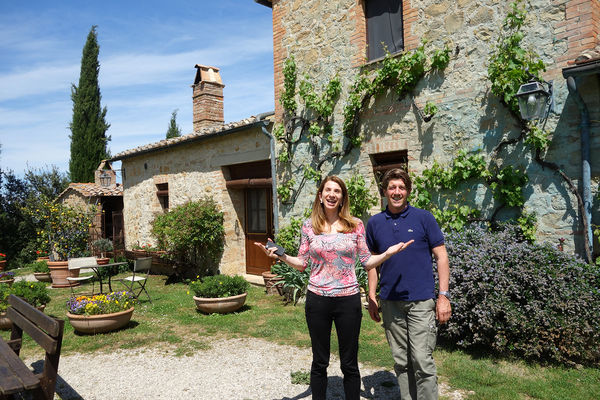Agriturismi: Italy’s Countryside Escapes
Staying in an 'agriturismo' — rural guesthouse — is a beautiful way to experience the heart of the Italian countryside, especially in Tuscany.
By Rick Steves

To connect with the rural charm that defines Tuscany, consider exploring by car and staying not in towns but in farmhouses. Savvy travelers can slow down and get a taste of Italian rural life in the traditional-yet-cozy lodgings of a countryside guesthouse or an agriturismo — a working farm that takes in guests.
As the names imply, these lodgings are in the countryside, although some are located within a mile of town. They make peaceful home bases for exploring the region, and are ideal for families. Some properties are simple and rustic, while others are downright luxurious, offering amenities such as swimming pools and riding stables.
Staying in these places is a beautiful way to get to the heart of Tuscany. And while these accommodations are diverse in style, their common denominator is the wonderful people you'll meet as your hosts.
Roberto Bechi, my favorite guide in the region, runs a farmhouse B&B perched on a bluff a 20-minute drive south of Siena. On one filming trip, my TV crew and I stayed at Roberto's place, where I enjoyed some memorable moments playing catch with his son. I found joy spending each evening fireside at the family hearth, catching up on my writing late into the night. And each morning, as the fire crackled, I'd watch the lifting fog slowly reveal the surrounding valleys.
Roberto always has some creative ways to get off the beaten path and closer to the culture. One time it was hunting for truffles (a regional specialty), followed by a visit to the local artichoke festival. Afterward, I joined Roberto's Slow Food group for a convivial lunch on a nearby farm. Our meal couldn't have been more fresh — local wine and cheese, crunchy bread, exquisitely pungent truffles on our pasta. The artichokes were gobbled down raw by young and old — a leafy delicacy. And our Florentine-cut steak was cooked just the way locals like it — rare — and sliced thin…good enough for a Medici prince.
Other countryside inns specialize in providing a particularly upscale experience amid the rolling Italian hills. I enjoy the vibe at Fonte Bertusi, a classy guesthouse near Pienza, where hosts Manuela and Andrea fill their place with vivid art, and even host art installations and occasional music events. The young hosts, along with Andrea's father Edoardo and their attention-starved cats, enjoy sharing their sublime views, swimming pool, and communal BBQ with guests looking for a serene getaway.
Some farmhouse B&Bs, like these, are not really working farms; if you want the real thing, make sure the owners call their place an agriturismo. Many were once fortified farms, reminders of battles between Florence and Siena centuries ago. In 1985, the Italian government began providing tax breaks for struggling family farms that opened their doors to travelers. To legally qualify as an agriturismo, a place must generate more money from its farm activities than from tourism, thereby ensuring that the land is worked and preserved.
One of my favorites — Agriturismo Cretaiole outside of Pienza — is an idyllic retreat for any romantic tourist, lovingly run by Isabella and Carlo. Isabella manages the business side of things while Carlo and his dad, Luciano, run the farm, producing vegetables, olive oil, wine, eggs, and cured meats. Isabella, a former city girl who fell in love with the farmer's son when she stayed here decades ago, has a knack for planning experiences that bring the region alive for her guests. Along with taking informative tours of the farm, guests might delve into wine-tasting, olive-harvesting, or pasta-making.
Other agriturismi offer a simpler experience of the countryside — the rough side of Tuscany. At the Villa Belsedere, a noble old farm estate run by the Gori family, you'll find no TV or specially arranged cooking classes. Here it's just you and big pigs, white lambs, and sweet-smelling hay.
Whether you're staying on a working farm or in a countryside inn, you'll usually find the rooms clean and comfortable, though they may be basic. Breakfast is often included, and mezza pensione (half-pension, meaning home-cooked dinner) may be built into the price. Kitchenettes are often available for you to cook up your own feast. It's wise to book several months in advance for high season (late April through mid-October). July and August are jammed with Italians and other European vacationers; in spring and fall, it's mostly Americans. Weeklong stays (typically Saturday to Saturday) are preferred at busy times, but shorter stays are possible off-season.
Tuscany is trendy, and it's a land of high contrasts — everything here is either extremely touristy or seductively in the rough. No matter your travel style, sitting down with a farm family at classic Tuscan table will confirm that la vita è bella.

